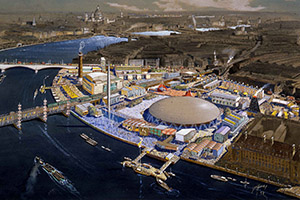
History-Periods
Past eras

From pre-history to today
Choose your period

Periods of History
explore the different eras

The Festival of Britain was a major national event that took place in 1951, aimed at celebrating British culture, industry, and achievements, and boosting national morale after the devastation of World War II. The Festival of Britain was a unique event in many ways, both in terms of its scale and its vision, and it had a significant impact on British society and culture.
The idea of a festival to celebrate Britain's achievements and promote its cultural heritage was first proposed in 1943, during the height of World War II. At the time, Britain was enduring a period of intense hardship and austerity, and the government was looking for ways to boost national morale and promote a sense of unity and purpose.
In 1946, the government established the Festival of Britain Office, which was responsible for organizing the festival. The festival was initially scheduled to take place in 1951, to coincide with the centenary of the Great Exhibition of 1851, but it was postponed until the following year due to logistical and financial difficulties.
The Festival of Britain was a massive event that took place across the country, with exhibits and events held in London and other cities and towns. The centerpiece of the festival was the Festival Pleasure Gardens, a large outdoor entertainment complex located on the South Bank of the River Thames in London.
The Festival Pleasure Gardens featured a variety of exhibits and attractions, including a funfair, a miniature railway, a lighthouse, a pavilion of futuristic design, and a large dome-shaped structure known as the Skylon, which was intended to symbolize Britain's technological and industrial progress. The Skylon was a particularly controversial feature of the festival, with some critics arguing that it was an ugly and pointless structure.
In addition to the Pleasure Gardens, the festival featured a range of exhibits and events celebrating British culture and industry. These included an exhibition of British art and design, a showcase of British film and theatre, a display of British industrial achievements, and a range of educational and scientific exhibits.
The Festival of Britain was an enormous success, attracting millions of visitors from across the country and around the world. It helped to promote a sense of national pride and optimism, and it provided a much-needed boost to the British economy, which was still recovering from the devastation of World War II.
The festival also had a significant impact on British culture and society. It helped to popularize modernist design and architecture, and it encouraged the development of new forms of popular entertainment, such as science fiction and fantasy. It also paved the way for the establishment of new cultural institutions, such as the Royal Festival Hall and the National Theatre, which were both built on the South Bank in the years following the festival.
However, the Festival of Britain was not without its critics. Some argued that it was too expensive and too focused on promoting a particular vision of British culture and identity. Others argued that it was too heavily influenced by modernist and avant-garde ideas, and that it failed to adequately represent the traditional and conservative aspects of British culture.
Despite these criticisms, the Festival of Britain remains an important and influential event in British cultural history. It represented a bold and ambitious attempt to promote British culture and industry on a national scale, and it helped to shape the course of British cultural and artistic development in the decades that followed.
The Great Exhibition of 1851 was an international exhibition held in London, England, from May 1 to October 15, 1851. It was the first of a series of world's fairs, which were designed to showcase the latest developments in industry and technology, and promote cultural exchange and international cooperation. The Great Exhibition was a significant event in the history of the Industrial Revolution and had a profound impact on the development of modern industry, design, and international relations.
The idea for the Great Exhibition was first proposed by Prince Albert, the husband of Queen Victoria, in 1849. The exhibition was intended to be a showcase of the latest achievements in industry and technology from around the world and was designed to promote the progress of civilization and international cooperation. The organizers of the exhibition hoped that it would also serve as a platform for the promotion of British industry and commerce.
The Great Exhibition was held in a specially-constructed building known as the Crystal Palace, which was designed by the architect Joseph Paxton. The Crystal Palace was a remarkable structure, made entirely of glass and iron, and covering an area of over 990,000 square feet. The design of the building was influenced by the principles of modern engineering and construction, and it was hailed as a triumph of the new industrial age.
The Great Exhibition attracted more than six million visitors from around the world, including heads of state, scientists, artists, and ordinary people. The exhibition featured more than 100,000 exhibits from 43 countries, including machinery, textiles, ceramics, furniture, and other products of industry and craft. Among the most popular exhibits were the telegraph, the sewing machine, and the hydraulic press.
The Great Exhibition had a significant impact on the development of modern industry and design. It provided a platform for the exchange of ideas and technologies between different countries and industries, and it helped to promote the development of new products and processes. The exhibition also helped to promote the principles of modern design, which emphasized simplicity, functionality, and aesthetic appeal.
The Great Exhibition had a profound impact on international relations, as well. It helped to promote the idea of international cooperation and understanding, and it paved the way for the establishment of future world's fairs and international exhibitions. The exhibition also helped to strengthen Britain's position as a global leader in industry and commerce, and it helped to establish London as a major center of international culture and exchange.
Overall, the Great Exhibition of 1851 was a remarkable event in the history of the Industrial Revolution and a significant milestone in the development of modern industry, design, and international relations. It remains a symbol of the achievements and aspirations of the Victorian era and an inspiration to future generations of engineers, designers, and entrepreneurs.
If you have a suggestion regarding additional topics you would like to see included - please let us know
Reference: Article by Greg Scott (Staff Historian), 2024
Tour Reviews
History Attractions
Submit Tour Suggestions
2024 Departures
Spotlight Tours
Events and anniversaries

All content and images are protected by copyright to Access History